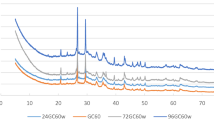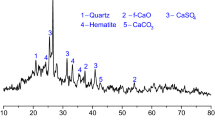Abstract
This paper investigates the influence of mechanical grinding on pozzolanic characteristics of circulating fluidized bed fly ash (CFA) from the dissolution characteristics, paste strength, hydration heat and reaction degree. Further, the hydration and hardening properties of blended cement containing different ground CFA are also compared and analyzed from hydration heat, non-evaporable water content, hydration products, pore structure, setting time and mortar strength. The results show that the ground CFA has a relatively higher dissolution rate of Al2O3 and SiO2 under the alkaline environment compared with that of raw CFA, and the pozzolanic reaction activity of ground CFA is gradually improved with the increase of grinding time. At the grinding time of 60 min, the pozzolanic reaction degree of CFA paste is improved from 6.32% (raw CFA) to 13.71% at 7 days and from 13.65 to 28.44% at 28 days, respectively. The relationships of pozzolanic reaction degree and grinding time of CFA also conform to a quadratic function. For ground CFA after a long-time grinding such as 60 min, the hydration heat and non-evaporable water content of blended cement containing CFA are significantly improved. Owing to relatively smaller particle size and higher activity of ground CFA, the blended cement paste has more hydration products, narrower pore size distribution and lower porosity. For macroscopic properties, with increase in grinding time of CFA, the setting time and strength of blended cement are gradually shortened and improved, respectively.


















Similar content being viewed by others
References
Wang CX, Zhu J. Developments in the understanding of gas-solid contact efficiency in the circulating fluidized bed riser reactor: a review. Chin J Chem Eng. 2016;24:53–62.
Gürtürk M, Oztop HF. Exergy analysis of a circulating fluidized bed boiler cogeneration power plant. Energy Convers Manag. 2016;120:346–57.
Selcuk N, Gogebakan Y, Gogebakan Z. Partitioning behavior of trace elements during pilot-scale fluidized bed combustion of high ash content lignite. J Hazard Mater. 2006;B137:1698–703.
Zhao JH, Wang DM, Liao SC. Effect of mechanical grinding on physical and chemical characteristics of circulating fluidized bed fly ash from coal gangue power plant. Constr Build Mater. 2015;101:851–60.
Koukouzas N, Ward CR, Papanikolaou D, Li ZS, Ketikidis C. Quantitative evaluation of minerals in fly ashes of biomass, coal and biomass-coal mixture derived from circulating fluidised bed combustion technology. J Hazard Mater. 2009;169:100–7.
Grela A, Łach M, Mikuła J, Hebda M. Thermal analysis of the products of alkali activation of fly ash from CFB boilers. J Therm Anal Calorim. 2016;124:1609–21.
Ahmaruzzaman M. A review on the utilization of fly ash. Prog Energy Combust Sci. 2010;36:327–63.
Reddy MS, Basha S, Joshi HV, Jha B. Evaluation of the emission characteristics of trace metals from coal and flue oil fired power plants and their fate during combustion. J Hazard Mater. 2005;B123:242–9.
Huang TY, Chiueh PT, Lo SL. Life-cycle environmental and cost impacts of reusing fly ash. Resour Conserv Recycl. 2017;123:255–60.
Wang Z. Study on properties and utilization in building materials of bottom ashes from circulating fluidized bed combustion (Ph.D. thesis). Chongqing University, Chongqing, China, 2002 (in Chinese).
Stevens W, Robl T, Mahboub K. The cementitious and pozzolanic properties of fluidized bed combustion fly ash. In: World of Coal Ash (WOCA) Conference. University of Kentucky, Lexington, KY, USA; 2009.
Fernandez R, Martirena F, Scrivener KL. The origin of the pozzolanic activity of calcined clay minerals: a comparison between kaolinite, illite and montmorillonite. Cem Concr Res. 2011;41:113–22.
Gao QY, Zhang ZQ. Study on the structural change in the calcinations process of kaolinite and its pozzolanic activity. J Chin Ceram Soc. 1989;17:541–8 (in Chinese).
Wang MR, Guo N, He PG, Yu JB, Jia DC. Formation mechanism and its pozzolanic activity of metakaolin. Key Eng Mater. 2014;8:620–3.
Bich C, Ambroise J, Péra J. Influence of degree of dehydroxylation on the pozzolanic activity of metakaolin. Appl Clay Sci. 2009;44:194–200.
Amer AA, El-hoseny S. Properties and performance of metakaolin pozzolanic cement pastes. J Therm Anal Calorim. 2017;129:33–44.
Li XG, Chen QB, Huang KZ, Ma BG, Wu B. Cementitious properties and hydration mechanism of circulating fluidized bed combustion (CFBC) desulfurization ashes. Constr Build Mater. 2012;36:182–7.
Shon CS, Mukhopadhyay AK, Saylak D, Zollinger DG, Mejeoumov GG. Potential use of stockpiled circulating fluidized bed combustion ashes in controlled low strength material (CLSM) mixture. Constr Build Mater. 2010;24:839–47.
Sheng GH, Li Q, Zhai JP. Investigation on the hydration of CFBC fly ash. Fuel. 2012;98:61–6.
Illikainen M, Tanskanen P, Kinnunen P, Körkkö M, Peltosaari O, Wigren V, Österbacka J, Talling B, Niinimäki J. Reactivity and self-hardening of fly ash from the fluidized bed combustion of wood and peat. Fuel. 2014;135:69–75.
Fu XR, Li Q, Zhai JP, Sheng GH, Li FH. The physical-chemical characterization of mechanically-treated CFBC fly ash. Cem Concr Compos. 2008;30:220–6.
Anthony EJ, Berry EE, Blondin J, Bulewicz EM, Burwell S. Advanced ash management technologies for CFBC ash. Waste Manag. 2003;23:503–16.
Payá J, Monzó J, Borrachero MV, Peris E. Mechanical treatment of fly ashes. Part I: physico-chemical characterization of ground fly ashes. Cem Concr Res. 1995;25:1469–79.
Bondar D, Coakley E. Effect of grinding on early age performance of high volume fly ash ternary blended pastes with CKD & OPC. Constr Build Mater. 2017;136:153–63.
Zhao JH, Wang DM, Wang XG, Liao SC, Lin H. Ultrafine grinding of fly ash with grinding aids: impact on particle characteristics of ultrafine fly ash and properties of blended cement containing ultrafine fly ash. Constr Build Mater. 2015;78:250–9.
Feng JJ, Liu SH, Wang ZG. Effects of ultrafine fly ash on the properties of high-strength concrete. J Therm Anal Calorim. 2017;125:1213–23.
Zhang TS, Yu QJ, Wei JX, Zhang PP. Effect of size fraction on composition and pozzolanic activity of high calcium fly ash. Adv Cem Res. 2011;23:299–307.
Zhao JH, Wang DM, Yan PY, Zhang DW, Wang H. Self-cementitious property of steel slag powder blended with gypsum. Constr Build Mater. 2016;113:835–42.
Sarita R, Singh NB, Singh NP. Interaction of tartaric acid during hydration of portland cement. Indian J Chem Technol. 2006;13:255–61.
Wu ZW, Lian HZ. High performance concrete. Beijing: China Railway Publishing House; 1999 (in Chinese).
Acknowledgements
This work was financially supported by Key Laboratory of Advanced Civil Engineering Materials (Tongji University), Ministry of Education (No. 201602).
Author information
Authors and Affiliations
Corresponding authors
Rights and permissions
About this article
Cite this article
Zhao, J., Li, D., Liao, S. et al. Influence of mechanical grinding on pozzolanic characteristics of circulating fluidized bed fly ash (CFA) and resulting consequences on hydration and hardening properties of blended cement. J Therm Anal Calorim 132, 1459–1470 (2018). https://doi.org/10.1007/s10973-018-7103-4
Received:
Accepted:
Published:
Issue Date:
DOI: https://doi.org/10.1007/s10973-018-7103-4




